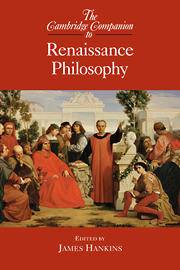Book contents
- Frontmatter
- 1 Introduction
- Part I Continuity and Revival
- Part II Toward Modern Philosophy
- 9 Nicholas of Cusa and modern philosophy
- 10 Lorenzo Valla and the rise of humanist dialectic
- 11 The immortality of the soul
- 12 Philosophy and the crisis of religion
- 13 Hispanic scholastic philosophy
- 14 New visions of the cosmos
- 15 Organizations of knowledge
- 16 Humanistic and scholastic ethics
- 17 The problem of the prince
- 18 The significance of Renaissance philosophy
- Appendix: Brief biographies of Renaissance philosophers
- Bibliography
- Index
16 - Humanistic and scholastic ethics
from Part II - Toward Modern Philosophy
Published online by Cambridge University Press: 28 November 2007
- Frontmatter
- 1 Introduction
- Part I Continuity and Revival
- Part II Toward Modern Philosophy
- 9 Nicholas of Cusa and modern philosophy
- 10 Lorenzo Valla and the rise of humanist dialectic
- 11 The immortality of the soul
- 12 Philosophy and the crisis of religion
- 13 Hispanic scholastic philosophy
- 14 New visions of the cosmos
- 15 Organizations of knowledge
- 16 Humanistic and scholastic ethics
- 17 The problem of the prince
- 18 The significance of Renaissance philosophy
- Appendix: Brief biographies of Renaissance philosophers
- Bibliography
- Index
Summary
Two approaches to the teaching of ethics
Renaissance humanists are known for the interest they took in ethics and moral philosophy. Many of them may have found it hard to practice virtues such as modesty and friendship, but countless letters, treatises, and dialogues (penned by authors such as Petrarch, Leonardo Bruni, and Erasmus) testify to their preoccupation with ethical issues. It is significant that the studia humanitatis (the cycle of humanist studies that included literature and history) had as their goal the formation of the perfect man, prominent for his virtue as much as for his eloquence (vir bonus dicendi peritus).
It would be a mistake, however, to regard the humanists as having revived the study of ethics after centuries of neglect. Scholastic writers had already given special attention to this subject, which they studied within the broader context ofmoral philosophy. Albert the Great (1200-80), one of the thirteenth-century architects of a renewed interest in Aristotelian thought, wrote two works on Aristotle’s Nicomachean Ethics and infected his student, Thomas Aquinas (1225-74), with a similar enthusiasm for the Stagirite’s moral treatises. Robert Grosseteste (1168-1253),Giles of Rome (1245-1316), Walter Burley (c. 1275-1344/5), and John Buridan (c. 1300 - after 1358) were only a few of the scholars who provided influential interpretations of Aristotelian moral philosophy in the late Middle Ages. Also, far from retreating into their supposed bunkers of logic and natural philosophy, scholastics of the Renaissance period wrote on moral philosophy even more prolifically than before. John Argyropoulos (c. 1415-87), a Greek émigré, provided a translation of the Ethics that was better received than Leonardo Bruni’s. In the sixteenth century, John Mair (1467/8-1550), Crisostomo Javelli (c. 1470/2-1538), and Francisco Suárez (1548-1617) wrote important works on ethics and politics. Several times, Averroes’ middle commentary on the Ethics was reprinted.
- Type
- Chapter
- Information
- The Cambridge Companion to Renaissance Philosophy , pp. 304 - 318Publisher: Cambridge University PressPrint publication year: 2007
- 11
- Cited by

